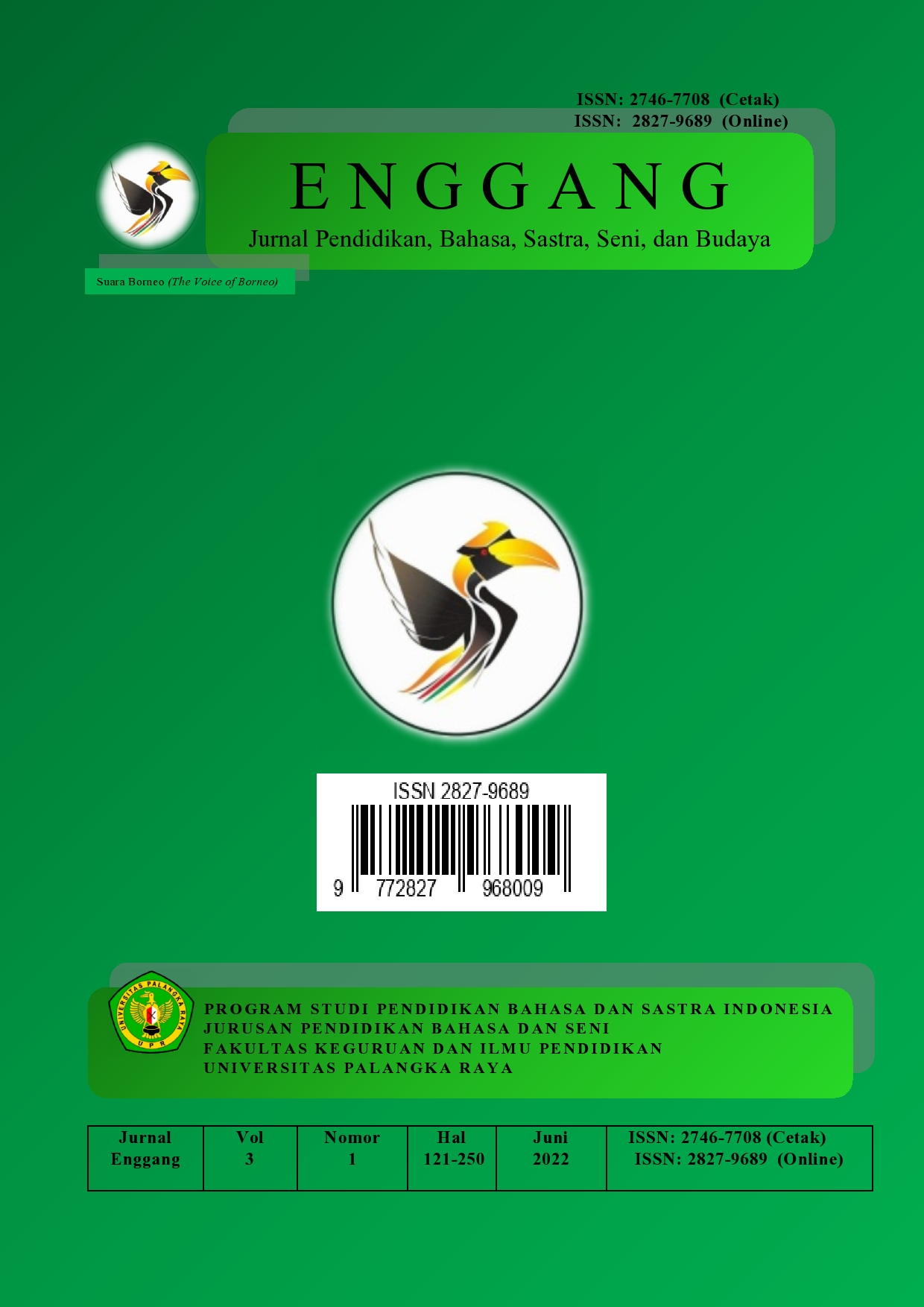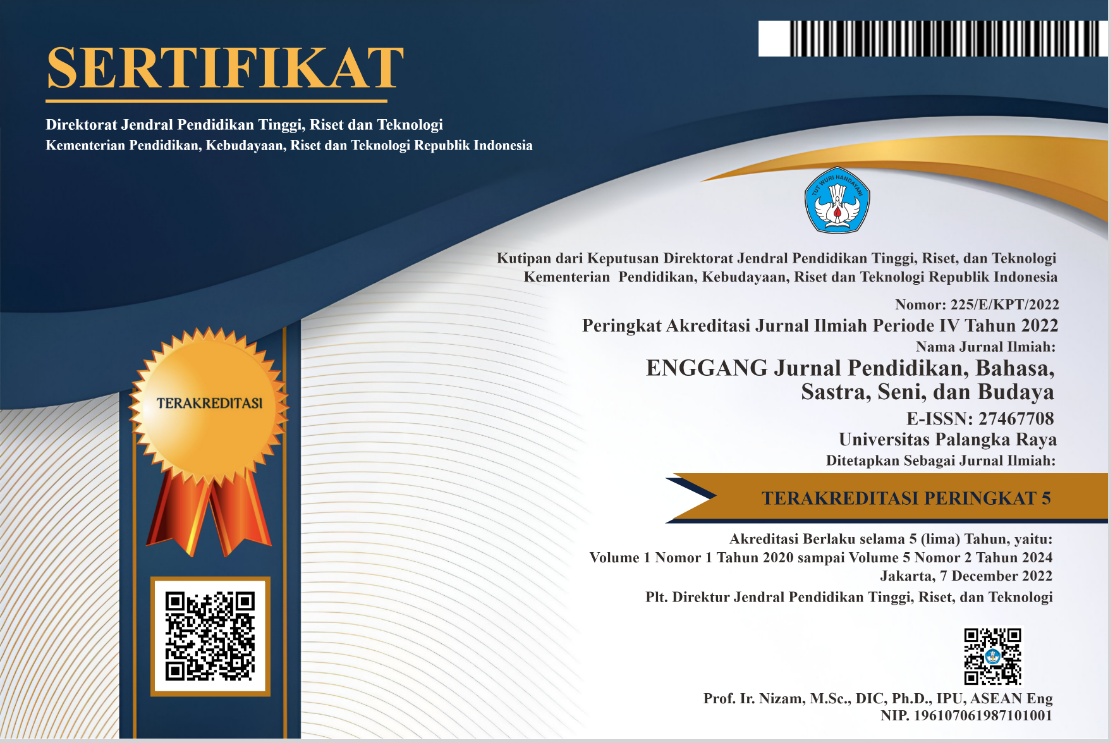The Portrayal of the Main Character’s Hegemonic Masculinity Dispositions in Natsume Soseki’s Botchan: A Gender Study Perspective
DOI:
https://doi.org/10.37304/enggang.v5i1.19685Keywords:
Disposition, Gender, Hegemonic MasculinityAbstract
Literature can be the window to discern new perspectives about life and broaden the reader’s horizons. Botchan by Natsume Soseki is a novel that has a big theme about morality which can be comprehended by the archetypes of the people from a big city and remote area, yet the polemic that appeared is rooted in the discrepancy of the characters’ dispositions. The writers attempt to analyze it in the frame of gender study which later gets elaborated with the hegemonic masculinity in two questions: “In what way does Botchan represent hegemonic masculinity?” and “How do the hegemonic masculinity dispositions within Botchan affect Botchan’s relations with Hotta, Mr. Yoshikawa, and Red Shirt?” The writers utilized the close reading method alongside the gender study approach. The hegemonic masculinity from Botchan attracts the character with a similar disposition (Hotta) and dissociates with Red Shirt and Mr. Yoshikawa that do not embody hegemonic masculinity dispositions. The indicator for hegemonic masculinity is determined by multiple factors, such as strength, competitiveness, assertiveness, confidence, and independence. Hegemonic masculinity is a glimpse of the extensive range of the definition of masculinity, therefore it is fenceless for arguments from other notions.
Downloads
References
Amir, R. A. I. (2014). Kritik sosial pada novel Botchan (坊ちゃん) karya Natsume Soseki (suatu tinjauan strukturalisme genetik). Universitas Hasanudin.
Austin, S. (2022). The importance of literature in modern society. Findcourses.co.uk.
Bates, T. R. (1975). Gramsci and the theory of hegemony. Journal of the History of Ideas, 36(2), 351-366. https://doi.org/10.2307/2708933
Bhatti, F. (2022). Masculinity studies: An interdisciplinary approach. IntechOpen. https://doi.org/10.5772/intechopen.107381
Bohan, J. S. (1993). Regarding gender: Essentialism, constructionism, and feminist psychology. Psychology of Women Quarterly, 17(1), 1-14. https://doi.org/1111/j.1471-6402.1993.tb00673.x
Gerwin, D. (2022). Deconstructing the masculinity of Hercules. Hyperallergic. https://hyperallergic.com/735802/deconstructing-the-masculinity-of-hercules/
Ghaisani, S. A. (2017). Kepribadian tokoh utama Botchan dalam novel Botchan karya Natsume Soseki (kajian psikoanalisis). Universitas Diponegoro.
Gottschall, M. (2002). The ethical implications of the deconstruction of gender. Journal of the American Academy of Religion, 70(2), 279-299. https://doi.org/10.2307/1466463
Haig, D. (2000). Of sex and gender. Nature Genetics, 25(4), 373. https://doi.org/10.1038/78033
Halley, C. (2022). Gender studies: Foundations and key concepts. JSTOR Daily. https://daily.jstor.org/reading-list-gender-studies/
Helgeson, V. S. (2011). The psychology of gender (4th ed.). Pearson.
Hoey, A. (2020). Under the sea: The depiction of gender roles and femininity in The Little Mermaid. https://doi.org/10.5281/zenodo.4008622
Johnson, B. (1985). Teaching deconstructively. In Writing and reading differently: Deconstruction and the teaching of composition and literature (p. 140). ISBN 978-07000002832. OCLC 65306717.
Jones, E. (2023). Psychoanalytic study of Hamlet by Ernest Jones (Critical writing). https://ivypanda.com/essays/the-psychoanalytic-hamlet-by-ernest-jones/
Kowarski, I. (2021). What a gender studies degree is, and how to use it. US News & World Report. https://www.usnews.com/education/best-graduate-schools/articles/what-gender-studies-is-and-how-to-use-the-degree
Lerner, G. (1986). The creation of patriarchy. Oxford University Press.
Mann, M., & Krane, V. (2016). Fair treatment in sport. Elsevier eBooks. https://doi.org/10.1016/b978-0-12-809324-5.05564-4
McGuire, P. (2015). Beyond the binary: What does it mean to be genderfluid? The Irish Times.
Messner, M. (1990). Sport, men, and the gender order: Critical feminist perspectives. Human Kinetics Books.
Murfin, R. C., & Smith, J. M. (1996). Feminist and gender criticism and Heart of Darkness. In R. C. Murfin (Ed.), Case studies in contemporary criticism (pp. 113-131). Palgrave.
Retno, W. (2017). Morals and personality of Botchan in Natsume Soseki’s Botchan. Universitas Negeri Yogyakarta.
Soseki, N. (1918). Botchan (Y. Morri, Trans.). Ogawa Seibundo. (Original work published 1906).
The Complete Review. (2021). Botchan - Natsume Soseki. https://www.complete-review.com/reviews/soseki/botchan.htm
Tikkanen, A. (2023). Natsume Sōseki. Encyclopedia Britannica. https://www.britannica.com/biography/Natsume-Soseki
Weber, M. (1946). Essays in sociology (H. H. Gerth & C. Wright Mills, Eds.). Oxford University Press.
Woodward, K., & Woodward, S. (2015). Gender studies and interdisciplinarity. Palgrave Communications, 1, 15018. https://doi.org/10.1057/palcomms.2015.18












